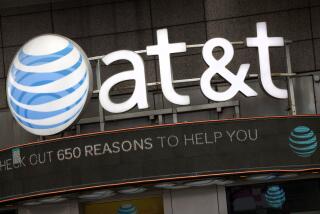Right Call? : 10 Years Later, AT&T; Split Favors Business
- Share via
It’s been a decade since the biggest company in the world agreed to break itself up in the most sweeping experiment in American industrial perestroika ever.
And what have we got to show for it?
Telephones answered by machines. Phone bills that take an accounting degree to decipher. Sex-talk lines. Tape-recorded sales pitches.
For this, we killed Ma Bell?
Like disgruntled citizens of a dismantled empire longing for the good old days of stability and simplicity, some American consumers are still traumatized by the breakup of the country’s most familiar monopoly.
Long-distance calls are far cheaper, and offices and factories are more efficient because of the greater choice of equipment, long-distance companies and hard-working machines that act both as phones and computers. But some people still aren’t sure they asked for all this confusing variety.
And some experts say consumers haven’t really gained that much by the restructuring of the U.S. phone industry, which in effect removed the large subsidy that businesses and other heavy long-distance users paid to keep local phone service cheap.
“The U.S. business community has been a big, big winner,” says Bill Davidson, a management professor at USC. “Their options have increased and prices dropped dramatically.
“But when you look at non-business consumers, frankly, there’s been very little positive news,” says Davidson, who had to walk a mile from his hotel in Kauai to return a reporter’s phone call because the area’s lines had been inexplicably dead for 16 hours.
What the numbers say is that although businesses have seen windfall savings, consumers have come out slightly ahead of where they were a decade ago.
Long-distance rates have dropped 40% and local rates have risen 53% since the breakup. Compared to other consumer expenses, overall phone service is still a bargain, its cost rising a little more than half as fast as everything else in the past decade. Experts conclude that telephone service quality, Kauai and La Guardia Airport blackouts aside, has improved.
Overall, Americans now spend about 2% of their incomes on phone service--the same amount they did before the wrenching changes that came with AT&T;’s breakup. But they’re spending a lot more time on the phone.
Not surprisingly, Bert Roberts, president of MCI, the long-distance company whose revenues grew tenfold to $7.7 billion in the past decade, believes that everyone ‘from the biggest company to the smallest consumer” has benefited from increased competition.
“When I was growing up, a long-distance call was an event around the house. You put out a little egg timer and when the salt ran out you better hang up,” Roberts says. “To my kids, it’s just another call.”
Indeed, long-distance phone calls, like oranges and air conditioners, have gone from luxury to commodity. In 1930, a 10-minute call from Los Angeles to New York cost $33--or $272 in 1991 dollars. In inflation-adjusted dollars, by late 1991 it was only $2.45.
When it happened, the breakup of AT&T; seemed nearly as shocking for the 1 million Bell System employees (more troops than the U.S. Army had then)--and 70 million customers--as the breakup of a country. AT&T;, with assets of $150 billion, was indeed vast--bigger than General Motors, General Electric, U.S. Steel, Eastman Kodak and Xerox combined.
It was Jan. 8, 1982, that AT&T; announced that it had settled an antitrust suit by the U.S. Department of Justice by agreeing to divest itself of the local Bell telephone companies.
The banner headlines on the divestiture were as big as for breakup of the Soviet Union in 1991. Experts and AT&T; managers described the breakup into regional fiefdoms as the tragic dissolution of a great nation with its own culture and unique ethos. Sociologists and psychologists flocked to study the enormous experiment.
Hundreds of thousands of managers used to a comfortably regulated world of lifetime employment, centralized five-year plans and a deep-seated belief that the rich should subsidize the phone service of the poor were suddenly thrust into an unfamiliar world of competition, freer markets--and layoffs that along with the divestiture shrank AT&T;’s telephone work force by 745,000 people.
“Few governmental actions since World War II,” predicted business guru Peter F. Drucker about the breakup, “will have such profound impact on American society, on American technology and even on national security.”
Starting in 1984, under the guidance of U.S. District Judge Harold Greene, AT&T; was cut off from the local phone companies, the “Baby Bells,” which were to continue as virtual monopolies and quasi-utilities in a still heavily regulated environment, providing local phone service while staying out of the lucrative long-distance, manufacturing and information services markets.
The new AT&T--which; would include a reconfigured version of its manufacturing arm, Western Electric, and research division, Bell Labs--was to compete with MCI, Sprint and foreign manufacturers, with much reduced regulation.
In the year after the breakup, service declined and business-people fumed as the backlog of delayed installations of new lines swelled. Cheap new phones (first allowed in the market several years earlier) flooded the market and promptly broke. When a phone went dead, people didn’t know whom to call.
Since then, service has improved greatly and prices have fallen, as deregulation advocates predicted. But the angst and anger have not ceased; one professor titled his book on the breakup “Wrong Number.”
Not everyone would agree. Business telephone customers have seen expenses drop and productivity-building services increase. Large corporations have seen long-distance rates drop even more than the overall 40% as they negotiate volume discounts.
A look at the phones at Merisel, a large national personal computer and software wholesaler, shows how businesses have benefited from the relative drop in one of their major expenses. The El Segundo-based company has seen its per-minute costs for the 800 numbers its customers use drop by half in just the past two years. And it has obtained new technology that in effect quadruples its phone line capacity without a rise in price.
Its phones are as important a business tool as its mainframe IBM computer. “The phone used to be an appliance. Now it’s a productivity tool,” says Dino Farfante, who uses a PC hooked to his sales staff’s phone lines to analyze trends in calls from, for instance, Milwaukee or Boston and to see which of his employees is most productive.
Telephone systems have become, in the words of one industry executive, “computers with long wires.” Two huge industries have lost the border between them. Networks of personal computers “talking” to each other over private and public telephone lines are replacing mainframe computers themselves.
Newspapers, cable television carriers and telephone companies are becoming fierce rivals to deliver information and entertainment.
But although much of this innovation and most of the price drops came after AT&T;’s breakup, they were not entirely caused by it. Even before divestiture, deregulation and competition had begun.
And technological advances had been popping out of Bell Labs, home to seven Nobel Prize winners, at the formidable rate of a patent a day, long before before it faced real competition.
But few doubt that the breakup of AT&T; has helped push change forward.
There was some bad news too. The Baby Bells became obligated to give all comers, and not just Ma Bell, an equal chance to sell them equipment. That created a huge new market, and competition gave them much cheaper prices on equipment.
It also gave foreign manufacturers a huge spot in the U.S. market. From a positive $817-million balance of trade in telecommunications equipment in 1981, the United States slipped into a $2.6-billion deficit in 1988 and hasn’t recovered.
But while the United States saw its own market invaded by foreign competition, its companies were also beginning to look overseas more than before. AT&T; charged into overseas projects. MCI and Sprint offered services to scores of foreign countries.
And the “local” Baby Bells, severely restricted in their own markets by remaining regulation, went international. The regional Bells have variously announced plans to build optical fiber cable across Siberia, cellular phones systems in Hungary, cable TV systems in Liverpool, beeper pagers in Bangkok and to sell yellow pages in China.
The Baby Bells have done much better than many expected. But they’ve had a rocky road, stumbling in their diversification ventures in real estate and finance. And they face increased competition in the local phone business, the last bastion of regulation.
Local Bell companies have also come under attack by consumer groups, which charge that they have drained funds from their monopoly profits from the captive customers of their regulated phone services and poured them into unregulated businesses such as property development and foreign exchange deals.
And the future? Some new services, such as home shopping and banking, electronic yellow pages and movies delivered by phone lines, are under development or in test phases. Some of these products have been on the drawing boards for years, but how soon they reach the market depends less on technology, which is within reach, and more on figuring out whether customers really want them.
AT&T; Breakup: The Right Choice? The Cost of Local Calls Is Higher. . . Since AT&T; agreed to its own dismantling and competition increased, long-distance rates have plunged and local rates have risen. Overall, phone rates have increased, but much more slowly than other consumer expenses. The chart tracks phone rates against the consumer price index. All four indexes use 1981 as a base of 100.
. . .but Long-Distance Rates Have Fallen In inflation-adjusted dollars, long-distance rates have dropped dramatically. 1930: $271.51 ‘40: $128.57 ‘50: $38.20 ‘60: $29.94 ‘70: $15.94 ‘80: $6.95 ‘91: $2.45 Los Angeles to New York, 10-minute daytime call, in 1991 dollars Source: Federal Communications Commission
More to Read
Inside the business of entertainment
The Wide Shot brings you news, analysis and insights on everything from streaming wars to production — and what it all means for the future.
You may occasionally receive promotional content from the Los Angeles Times.









